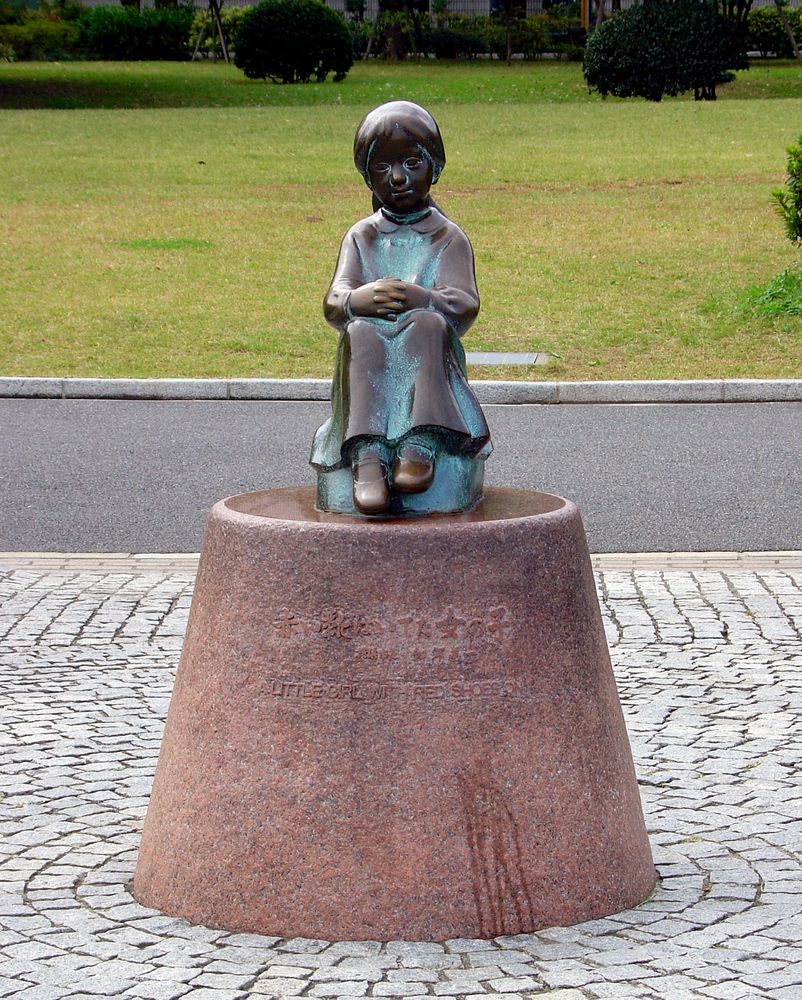In Yamashita Park in Yokohama there is a famous statue of “The Little Girl with Red Shoes On.” The statue represents the subject of a song that is one of the most famous songs in Japan and is associated specifically with Yokohama. The song is called “Akai Kutsu” (“Red Shoes”):
A little girl nice in her pretty red shoes
Has gone far away, taken by a foreigner (American).
From the port of Yokohama, over the waves,
She has gone with him to his home.
I wonder if she is happy and has nice days.
I wonder if her eyes are blue like a foreigner’s.
I remember her when I see pretty red shoes.
I wonder how she is when I meet a foreigner.
The song’s lyrics were written by a Japanese poet called Ujo Noguchi, and the musical composer was Nagayo Motori. Motori (1885–1945) was a descendant of Norinaga Motori, a famous scholar of Japanese literature who studied music and composed many children’s songs. Norinaga is even supposed to have composed the first Japanese children’s song.
The song is based on a true story; although versions of the story vary somewhat, the general gist of it is as follows. The little girl in the song is Kimi Iwasaki, born July 15, 1902, in a village in the foothills of old Shizuoka prefecture that was then called Fujimi-mura (it is now in the Shimizu ward of the city of Shizuoka). At the age of three, Kimi was adopted by an American missionary couple, Charles Hewett (or Huit) and his wife. Her mother, Kayo, being poor, had surrendered her in the belief that she was doing the best thing for her daughter.
In the song, a young girl accompanies a foreigner by ship from Yokohama, presumably headed for the United States. Her mother wonders if she is happy and if her eyes have turned blue like a foreigner’s. The lyrics reflect Kayo’s belief that the Hewetts had taken Kimi home with them.
In fact, contrary to the words of the song, Kimi had never left Japan at all. When it was time for the Hewetts to leave, it was discovered that she had tuberculosis, which was incurable at that time. It seemed doubtful that she would survive the long ocean voyage, so she was left in a Methodist church orphanage in the Azabu-Juban section of Tokyo. There Kimi died on September 15, 1911, at the age of nine. The orphanage has been identified as being associated with the Toriizaka Church, which stood at Azabu-Nagasaka between 1877 and 1923. According to one Web site (if I am reading it correctly), this is now the site of the “Harvest God” Shinto shrine in Jūban.
Meanwhile, Kayo Iwasaki had married Shiro Suzuki and migrated with him to Hokkaido, where the couple tried to eke out a living as pioneer farmers. They were unsuccessful, suffering family deaths and farm fires, before finally moving to Sapporo, where Shiro found a job in a small newspaper publishing company called Hokumeishinpo;.
One of Shiro’s co-workers at the newspaper was Ujo Noguchi. Noguchi heard Kimi’s story from her mother and wrote the lyrics to “Akai Kutsu” (Red Shoes). In later years, it is said that Kayo would often say, “Ujo made that song for you, Kimi,” and sing “A Little Girl Wearing Red Shoes,” her voice full of sadness and regret.
Almost every Japanese person has heard or sung this song at one time or another. Yet few, if any, were aware of Kimi’s true plight until a Hokkaido newspaper chanced to publish a story on the girl’s tragic life in November 1973, and her life became widely known around the country.
In February 1989 a statue of Kimi was erected in Tokyo (in a shopping center in Azabu-Juban). On the day it was first unveiled someone left 40 yen at its feet. A charity was born, and today millions of yen have been collected and donated to UNESCO and other childcare charities.
Although that statue may be more profitable for UNESCO than the one in Yokohama, it is not (in my opinion) as attractive.
Source: http://sbarnhill.mvps.org/japan/attractions/AkaiKutsu.htm
 Auf dem Wasser
Auf dem Wasser
 Auf der Schiene
Auf der Schiene
 Auf der Straße
Auf der Straße
 In der Luft
In der Luft
 Blumen und Blüten
Blumen und Blüten
 Blumen in Vasen
Blumen in Vasen
 Dahlien
Dahlien
 Orchidee
Orchidee
 Heimische Tiere
Heimische Tiere
 Kleiber Günther
Kleiber Günther
 Greifvögel und Eulen
Greifvögel und Eulen
 Beeren und Früchte
Beeren und Früchte
 Dresdner Gaslaternen
Dresdner Gaslaternen
 Straßen und Gebäude
Straßen und Gebäude
 Fahrzeuge
Fahrzeuge
 Fotografiegeräte
Fotografiegeräte
 Kultur & Kunst
Kultur & Kunst
 Makros
Makros
 Menschen
Menschen
 Natur und Landschaft
Natur und Landschaft
 Stilleben
Stilleben
 Zoobilder
Zoobilder

